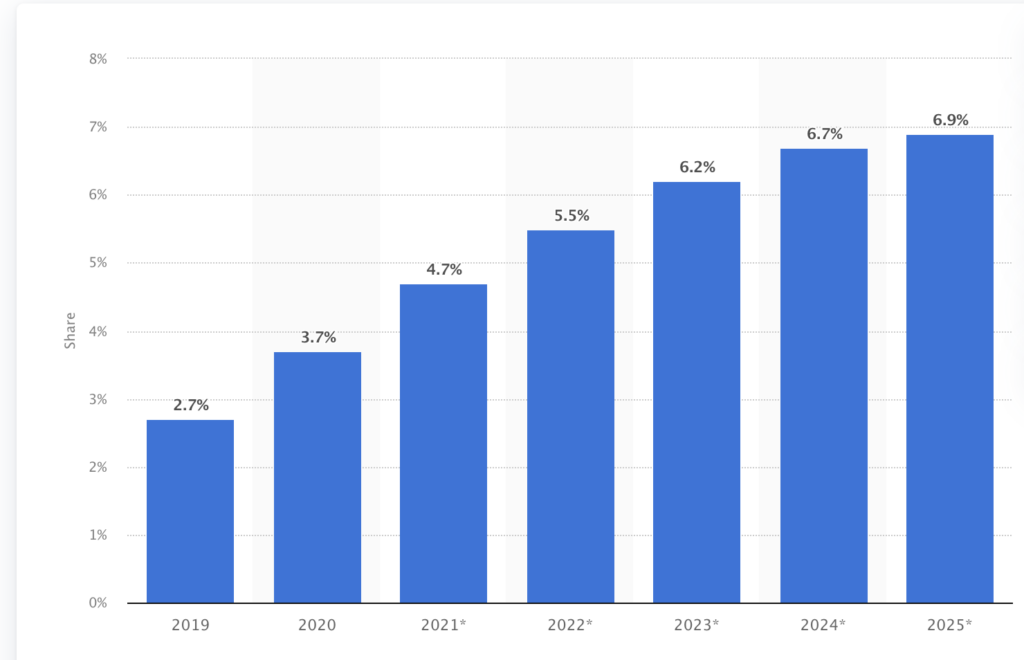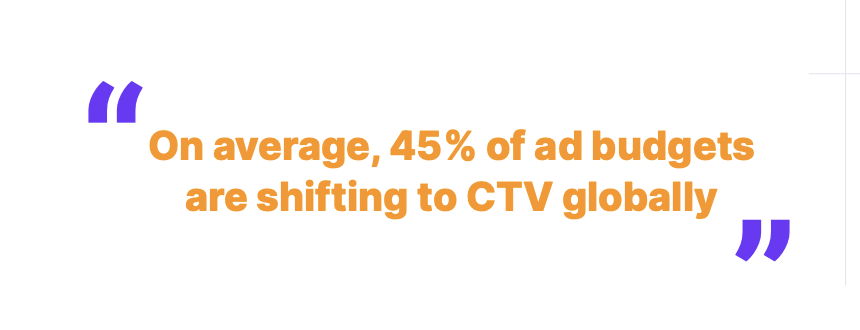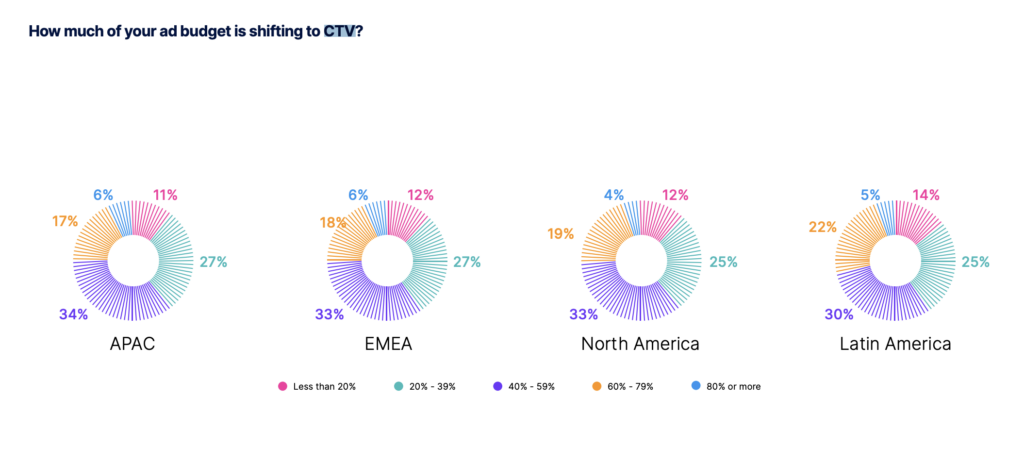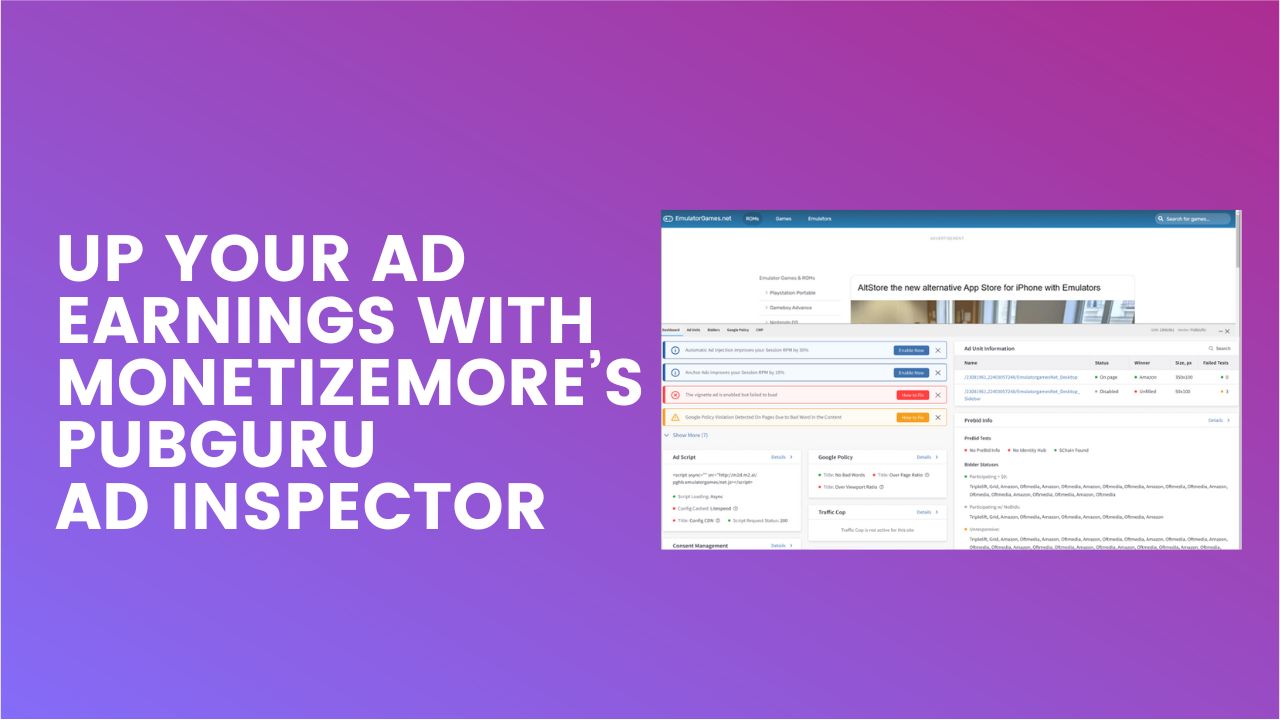
This post was most recently updated on January 3rd, 2024
Connected TV (CTV) has exploded in popularity in recent years, driven by the growth of streaming services and cord-cutting. For publishers, CTV represents a lucrative opportunity to reach audiences in a highly engaging and measurable way. However, the CTV space is also characterized by intense competition, fragmentation, and rapidly evolving technology. In this article, we will explore the state of CTV for publishers in 2024, examining the growth, opportunities, challenges, and best practices for success in this exciting and dynamic market.
Over the past decade, digital advertising has grown tremendously, and Connected TV (CTV) is one of the fastest-growing segments. CTV is a type of television that is connected to the internet and allows viewers to stream content from various sources such as YouTube, Netflix, and Hulu. The rise of CTV has been driven by the increasing number of households that have cut the cord with traditional cable TV providers and switched to streaming services.
According to industry experts, the revenue for CTV advertising is projected to grow at a compound annual growth rate (CAGR) of over 20% from 2020 to 2025. This growth rate is significantly higher than the CAGR of other segments of the advertising industry, such as print, radio, and out-of-home advertising. The growth of CTV advertising can be attributed to several factors, including the growing popularity of streaming services, the increasing number of CTV devices in households, and the ability to target specific audiences with personalized ads.

Furthermore, post-pandemic, more people are spending time at home and streaming content, resulting in a surge of interest in CTV advertising. As a result, businesses are looking to increase their advertising budgets to take advantage of this trend. The pandemic has also led to changes in consumer behavior, with more people opting for online shopping and home delivery services. This shift in behavior has created new opportunities for businesses to advertise their products and services on CTV platforms.
Another factor driving the growth of CTV advertising is the ability to measure the effectiveness of ad campaigns accurately. With traditional television advertising, it can be challenging to determine how many people saw an ad and how effective it was. However, with CTV advertising, it is possible to track how many people viewed an ad, how long they watched it, and whether they took any action, such as clicking on a link or making a purchase. This level of measurement and analytics provides businesses with valuable insights into the effectiveness of their ad campaigns and allows them to optimize their strategies accordingly.
CTV advertising is a rapidly growing segment of the digital advertising industry, with a projected CAGR of over 20% from 2020 to 2025. As businesses look to take advantage of this trend, we expect to see continued growth and innovation in the CTV advertising space.
The surge in digital video spending, particularly in CTV, reflects the audience’s shift to streaming. Examples include the staggering streaming usage in the U.S., Mexico’s growing streaming share of TV usage, Thailand’s high streaming reach, and Australia’s internet streaming prevalence. Advertisers prioritize targeting streaming audiences, highlighting the need for accurate measurement.
Connected TV (CTV) has become an increasingly popular way for people to consume media, with more and more viewers opting for streaming services and on-demand content. As a result, the advertising opportunities in the CTV space have exploded in recent years, with numerous media companies and publishers vying for a piece of the pie.
While there are many players in the CTV advertising space, some have established themselves as top publishers. These companies have invested heavily in creating high-quality content and building strong relationships with advertisers. Let’s take a closer look at some of the biggest CTV publishers:
Netflix: With over 200 million subscribers worldwide, Netflix is one of the largest streaming services in the world. The platform has invested heavily in creating original content, including hit shows like Stranger Things and The Crown, and has become a major player in the CTV advertising space.
It is reportedly partnering with Microsoft to launch a new ad-supported subscription plan. This collaboration aims to offer users a more affordable option by incorporating advertisements into the streaming experience. While Netflix has built its success on an ad-free model, this strategic move allows them to tap into a broader audience segment and potentially increase revenue streams. By teaming up with Microsoft, known for its advertising technology expertise, Netflix aims to strike a balance between user experience and financial sustainability in an ever-evolving streaming landscape.
Disney+: Disney Plus, the popular streaming service has already introduced its ad-supported business model in the U.S. This strategic move is aimed at providing a more affordable subscription option for users by integrating advertisements into the streaming content. While Disney Plus initially launched as an ad-free platform, the introduction of ads is expected to generate additional revenue streams and help offset the costs of producing high-quality content. By embracing this ad-supported approach, Disney Plus aims to strike a balance between offering affordable pricing and maintaining a vast library of diverse entertainment options for its subscribers.
Hulu: Owned by Disney, Hulu is another popular streaming service that has made a name for itself in the CTV space. The platform offers a mix of on-demand content and live TV, making it a popular choice for cord-cutters who still want access to live programming.
Amazon Prime Video: Amazon’s streaming service has also become a major player in the CTV advertising space. With a library of original content, including award-winning shows like The Marvelous Mrs. Maisel, Amazon Prime Video has attracted a large and loyal audience.
NBCUniversal: As one of the largest media companies in the world, NBCUniversal has a significant presence in the CTV advertising space. The company owns a number of popular networks, including NBC, Bravo, and USA, and has invested heavily in creating high-quality content for its viewers.
ABC: Another major broadcaster, ABC has also established itself as a top CTV publisher. The network offers a mix of live programming and on-demand content, including hit shows like Grey’s Anatomy and The Bachelor.
While these publishers have established themselves as major players in the CTV space, there is still room for smaller publishers to succeed. By focusing on niche audiences or creating unique content, smaller publishers can carve out a space for themselves in the competitive world of CTV advertising.
Connected TV (CTV) has revolutionized the way we consume video content. With the rise of CTV, we have seen numerous trends emerge that have transformed the advertising industry. Let’s dive deeper into some of the most interesting CTV trends.
In the realm of CTV (Connected TV) publishers, there is a notable trend toward both consolidation and fragmentation. While major players like Netflix and Disney Plus continue to dominate the market, smaller CTV publishers are also experiencing significant growth.
Netflix: As a pioneer in the streaming industry, Netflix has established a strong foothold and continues to expand its subscriber base worldwide. Its extensive library, original content, and global presence contribute to its consolidation of the CTV market.
Disney Plus: With its vast collection of beloved franchises and exclusive content, Disney Plus has quickly gained popularity and amassed a large subscriber base. The acquisition of other major entertainment companies, such as 21st Century Fox, has further solidified its position.
The emergence of New Players: Smaller CTV publishers, both established and emerging, are entering the market. Examples include Amazon Prime Video, Hulu, HBO Max, and Peacock. These platforms offer unique content and target specific audience segments, contributing to the fragmentation of the CTV landscape.
Niche and Regional CTV Publishers: Alongside the major players, niche and regional CTV publishers are gaining traction. These platforms cater to specific interests or target local markets, providing diverse content options and contributing to the fragmentation of the CTV ecosystem.
Overall, while industry leaders like Netflix and Disney Plus continue to dominate, the CTV market is witnessing the growth of smaller players, resulting in a combination of consolidation and fragmentation in the industry.
One of the most interesting trends in CTV is the rise of dynamic ad insertion (DAI). DAI technology allows advertisers to deliver personalized video ads to individual viewers, making the ads more relevant and engaging. This technology has become increasingly popular in recent years, as it enables advertisers to target specific audiences with relevant ads. With DAI, publishers can target different viewers based on demographics, interests, and location, which has proven to be highly effective in driving engagement and conversions.
For example, if a viewer in New York City is watching a cooking show on their CTV, DAI technology can deliver an ad for a local grocery store chain that is running a promotion on ingredients for a recipe featured in the show. This level of personalization has proven to be highly effective in driving engagement and conversions.
Another trend is the increasing use of programmatic advertising, allowing advertisers to more accurately target specific audiences. This has spurred growth in the use of supply-side platforms (SSPs) to manage ad inventory and make it available to demand-side platforms (DSPs) programmatically.
Programmatic advertising has become increasingly popular in recent years, as it enables advertisers to target specific audiences with relevant ads. By using data to target specific demographics, interests, and behaviors, programmatic advertising has proven to be highly effective in driving engagement and conversions.
For example, if a viewer has recently searched for a new car online, programmatic advertising can deliver an ad for a local car dealership that has the exact make and model the viewer is interested in. This level of personalization has proven to be highly effective in driving engagement and conversions.

As CTV continues to grow in popularity, we have seen the emergence of CTV advertising platforms that enable advertisers to reach their target audiences more effectively. These platforms offer a range of targeting options, including demographic, interest-based, and geographic targeting, allowing advertisers to reach their desired audiences with relevant ads.
CTV advertising platforms also offer advanced analytics and reporting, enabling advertisers to track the performance of their campaigns in real-time. This level of insight has proven to be highly valuable in optimizing campaigns for maximum effectiveness.
In conclusion, the rise of CTV has transformed the advertising industry, and we have seen numerous trends emerge that have revolutionized the way we consume and deliver video content.
From the rise of DAI to the increasing use of programmatic advertising, CTV has opened up new opportunities for advertisers to reach their target audiences more effectively.
As the use of programmatic advertising in CTV continues to grow, many SSPs have emerged to manage ad inventory. The main SSPs for CTV include Roku, SpotX, and Freewheel. These platforms manage the monetization of CTV inventory across millions of screens, helping publishers monetize their content and advertisers reach their intended audiences.
Roku, one of the most well-known SSPs for CTV, offers a comprehensive platform for publishers to manage their ad inventory. With over 50 million active accounts, Roku has a vast reach and allows publishers to monetize their content through a variety of ad formats, including pre-roll, mid-roll, and post-roll ads.
SpotX, another popular SSP for CTV, offers a programmatic platform that enables publishers to manage their inventory across multiple devices and platforms. SpotX’s platform allows publishers to optimize their ad inventory by targeting specific audiences and demographics, ensuring that ads are delivered to the right viewers at the right time.
Freewheel, a Comcast-owned company, is an SSP that specializes in managing ad inventory for premium publishers. With a focus on high-quality content, Freewheel offers a programmatic platform that enables publishers to monetize their inventory through a variety of ad formats, including interactive ads and branded content.
The growth of CTV is expected to continue in the coming years as more consumers adopt streaming services and smart TVs. In addition, the COVID-19 pandemic has accelerated the shift towards digital entertainment, as more people stay at home and seek out new forms of entertainment.
As the CTV market expands, new players are entering the space, including tech giants such as Apple and Google. These companies are investing heavily in original content and developing their own streaming services, which could further disrupt the traditional TV industry.
While traditional TV ads may be losing their effectiveness, CTV offers new opportunities for advertisers to reach audiences. CTV ads can be targeted to specific demographics and interests and can be delivered in a non-intrusive manner.
In addition, CTV ads are often more engaging than traditional TV ads, as they can be interactive and personalized. This can lead to higher engagement rates and better ROI for advertisers.
Connected TV (CTV) has emerged as a major force in the entertainment industry, driven by the rise of streaming services and smart TVs. While it presents new challenges for advertisers, it also offers new opportunities for targeting and engagement. As the market continues to evolve, it will be important for advertisers to stay up-to-date with the latest trends and developments in CTV advertising.
For publishers, CTV represents a massive opportunity to connect with audiences in a highly engaging and measurable way. Publishers can leverage CTV to deliver targeted ads, expand their content offerings, and build partnerships with streaming platforms.
Targeted advertising and personalization are two key opportunities for publishers in the CTV space. CTV platforms collect a wealth of data on viewers, including their viewing habits, demographics, and location. This data can be leveraged to deliver highly targeted ads that are more relevant and engaging to individual viewers.
Personalization is also critical to the success of CTV, as viewers expect a highly tailored and customized experience. Publishers can use data to deliver personalized recommendations, offer interactive content, and create immersive advertising experiences.
Expanding content offerings is another key opportunity for publishers in the CTV space. With the rise of streaming services, consumers have an insatiable appetite for content, and publishers that can deliver high-quality, engaging content are well-positioned to succeed.
Publishers can expand their content offerings by creating original shows, licensing content from other providers, and leveraging user-generated content. They can also experiment with new formats such as short-form video, live streaming, and interactive content.
Partnerships with streaming platforms are an effective way for publishers to expand their reach and access new audiences. By partnering with streaming platforms, publishers can gain access to a highly engaged and loyal user base, as well as advanced targeting and measurement capabilities.
Partnerships can take many forms, including content licensing, co-marketing campaigns, and data-sharing agreements. Publishers that can create unique and valuable partnerships are likely to see increased revenues and viewer engagement.

While the CTV market presents many opportunities for publishers, it also poses significant challenges. These challenges include competition with established players, fragmentation of the ecosystem, and maintaining user privacy and security.
The CTV market is characterized by intense competition, with established players such as Netflix and Amazon dominating the space. These players have built strong brands, loyal user bases, and vast libraries of content, making it difficult for smaller publishers to compete.
Smaller publishers need to focus on creating unique and engaging content, building strong brand identities, and leveraging data to deliver highly targeted and personalized experiences.
The CTV ecosystem is highly fragmented, with a multitude of devices, platforms, and apps competing for attention. This fragmentation can make it difficult for publishers to reach audiences effectively, as viewers may use different devices and platforms for different content.
Publishers need to adopt a cross-platform approach, creating content that is optimized for different devices and platforms. They also need to stay up-to-date with emerging technologies and industry standards, to ensure that their content is accessible and engaging across the full range of CTV devices.
User privacy and security are critical issues in the CTV space, as viewers share sensitive data such as viewing habits, location, and personal information. Publishers need to take steps to protect user data, including implementing strong data security measures, obtaining consent, and being transparent about data collection policies.
Publishers also need to work with advertisers to deliver ads that are both effective and respectful of user privacy. Effective ad targeting and personalization require access to data, but this data must be collected and used in a way that respects user privacy and builds trust with viewers.
Success in the CTV space requires a strategic approach, focused on delivering high-quality content, engaging user experiences, and effective monetization strategies. Here are some best practices for publishers in the CTV space.
Programmatic advertising has revolutionized the digital advertising industry, enabling highly targeted and efficient ad delivery. In the CTV space, programmatic advertising is becoming increasingly prevalent, offering publishers an effective way to monetize their content.
Publishers that embrace programmatic advertising can access advanced targeting and measurement capabilities, as well as real-time bidding and optimization. Programmatic advertising enables publishers to deliver highly relevant and engaging ads to viewers, while also maximizing their ad revenue. The RPM’s from CTV are much higher compared to web publishers. CTV platforms offer a premium advertising environment, often attracting high-demand advertisers seeking to engage with a highly engaged and targeted audience. The limited ad inventory on CTV platforms compared to the web can drive up competition among advertisers, resulting in higher ad rates and, consequently, higher session RPMs.
At the end of the day, success in the CTV space comes down to the quality of the content and user experience. Publishers need to focus on delivering high-quality, engaging content that resonates with viewers and builds brand loyalty.
Publishers also need to focus on creating seamless and engaging user experiences, across all devices and platforms. This includes optimizing user interfaces, delivering relevant and personalized content recommendations, and creating interactive and immersive experiences that keep viewers coming back for more.

Here’s a list of some up-and-coming CTV publishers that are gaining prominence in the industry:
Tubi: Tubi is a free ad-supported streaming service that offers a wide range of movies and TV shows. It has been rapidly growing its user base and content library, making it a notable player in the CTV space.
Roku Channel: The Roku Channel is a free streaming service available on Roku devices, offering a mix of ad-supported movies, TV shows, and live TV. With the increasing popularity of Roku devices, the Roku Channel has gained significant traction among viewers.
Pluto TV: Pluto TV is a free streaming service offering a variety of live channels and on-demand content. It provides a diverse range of programming across various genres and has experienced substantial growth, leading to its acquisition by ViacomCBS.
Crave: Crave is a Canadian streaming service that offers a combination of original content, premium TV shows, and movies. It has gained recognition as a prominent CTV publisher, particularly in the Canadian market.
fuboTV: FuboTV is a live TV streaming platform that focuses on sports content. It has expanded its offerings to include entertainment and news channels, attracting a dedicated audience of sports enthusiasts.
IMDb TV: IMDb TV is an ad-supported streaming service owned by Amazon, featuring a collection of movies and TV shows. With the backing of Amazon’s resources, IMDb TV has been steadily growing and expanding its content library.
The CTV landscape is dynamic, rapidly evolving, and highly competitive. For publishers, it represents a massive opportunity to reach audiences in a highly engaging and measurable way, but it also poses significant challenges.
Publishers that can navigate the CTV landscape by creating high-quality, engaging content, delivering seamless and personalized user experiences, and building strong brand identities and partnerships are well-positioned to succeed.
By embracing new technologies, experimenting with new content formats, and delivering innovative advertising experiences that are both effective and respectful of user privacy, publishers can thrive in the exciting and ever-changing world of CTV.

Kean Graham is the CEO and founder of MonetizeMore & a pioneer in the Adtech Industry. He is the resident expert in Ad Optimization, covering areas like Adsense Optimization,GAM Management, and third-party ad network partnerships. Kean believes in the supremacy of direct publisher deals and holistic optimization as keys to effective and consistent ad revenue increases.

Paid to Publishers
Ad Requests Monthly
Happy Publishers



10X your ad revenue with our award-winning solutions.